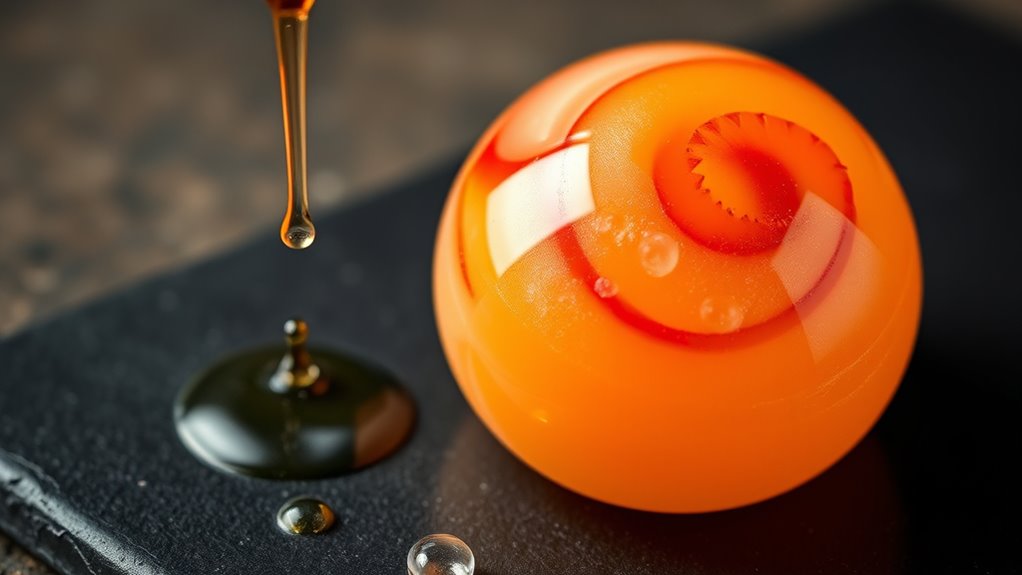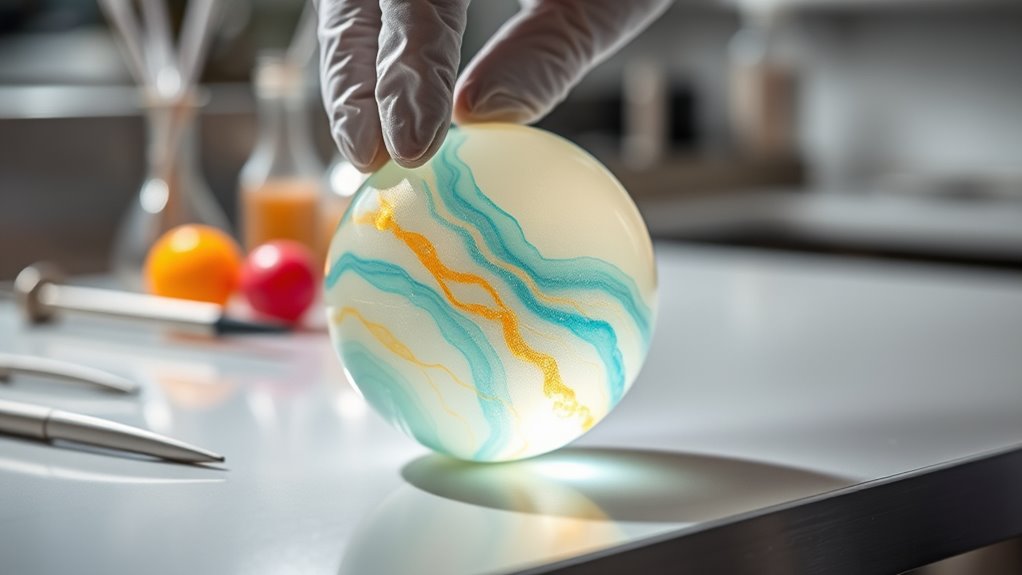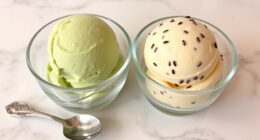Molecular gastronomy is revolutionizing gelato by allowing you to experiment with innovative flavors, textures, and presentation techniques. You can combine unexpected ingredients like balsamic with vanilla or create airy, cloud-like sensations, all through scientific manipulation. This approach enables you to push traditional boundaries and craft sensory-rich desserts with precision and creativity. If you keep exploring, you’ll discover how these scientific methods can transform your gelato-making into an artful and exciting experience.
Key Takeaways
- Molecular gastronomy enables innovative flavor pairings and unexpected taste combinations in gelato.
- It allows precise texture control, creating cloud-like, chewy, or airy sensations beyond traditional churning.
- Small molecular adjustments enhance or transform natural flavors, elevating sensory experiences.
- Techniques challenge and expand traditional gelato-making rules, fostering bold experimentation.
- Both chefs and home cooks can craft unique, multi-dimensional gelato varieties through scientific methods.

Molecular gastronomy has revolutionized the way we experience food, and gelato is no exception. With its innovative approach, chefs and artisans are pushing the boundaries of traditional flavors and textures, creating sensations that surprise and delight your palate. One of the most exciting aspects of this culinary revolution is flavor innovation. By manipulating ingredients at the molecular level, you can *release* new, unexpected taste combinations that weren’t possible before. Imagine tasting a classic vanilla gelato but with hints of balsamic vinegar or a strawberry that subtly combines with basil in a way that sparks your senses. This process allows you to experiment with textures and flavors, blending elements that challenge your expectations and make each spoonful an adventure.
Discover how molecular gastronomy transforms gelato into surprising, flavor-blending adventures.
Texture manipulation is another core technique in molecular gelato crafting. Traditional gelato relies on churning to achieve its creamy consistency, but with molecular methods, you can alter this texture in remarkable ways. For example, by using stabilizers and gelling agents, you can create gelato that feels like a cloud on your tongue or is surprisingly chewy, similar to mochi. You might even incorporate foams or airs that add a lightness to the dessert, giving it an almost ethereal quality. This control over texture lets you craft gelato that isn’t just about flavor but also about how it feels—whether it’s velvety smooth, icy and crisp, or unexpectedly chewy.
As you explore these techniques, you begin to see how molecular gastronomy isn’t just about adding scientific flair; it’s about enhancing your sensory experience. Flavor innovation allows you to craft taste profiles that defy traditional expectations, while texture manipulation transforms each bite into a multi-dimensional experience. You can combine ingredients in ways that amplify their natural qualities or introduce entirely new elements that excite your palate. The beauty lies in the precision—small changes at the molecular level can *dramatically* impact the overall sensation, making each scoop of gelato a unique encounter. Additionally, understanding food science principles can help you better control the outcomes and push creative boundaries in your culinary endeavors.
In essence, molecular gastronomy rewrites the rules of gelato making by enabling you to experiment boldly, blending flavors seamlessly and adjusting textures with pinpoint accuracy. It’s a dynamic, creative process that invites you to rethink what gelato can be. Whether you’re a professional chef or an enthusiastic home cook, embracing these techniques opens up a world of possibilities, transforming a simple dessert into a work of edible art filled with innovation and sensory delight.
Frequently Asked Questions
Can Molecular Gastronomy Techniques Be Applied to Traditional Italian Gelato?
You can definitely apply molecular gastronomy techniques to traditional Italian gelato. These methods allow you to explore flavor innovation by infusing unique tastes and textures. You might manipulate the gelato’s texture, making it creamier or more airy, which enhances the overall experience. Using spherification or foam techniques, you create exciting presentations and new sensory experiences, transforming classic gelato into modern culinary art while respecting its traditional roots.
What Safety Concerns Are Associated With Molecular Gastronomy in Gelato Making?
When using molecular gastronomy in gelato making, you should consider safety concerns like allergen management and chemical safety. You’re responsible for ensuring ingredients are clearly labeled and free from allergens, preventing cross-contamination. Additionally, handle chemicals and additives carefully, following proper storage and usage guidelines. This way, you protect your customers’ health while experimenting with innovative techniques, making your gelato both exciting and safe to enjoy.
How Does Molecular Gastronomy Impact the Nutritional Value of Gelato?
Think of molecular gastronomy as a chef’s toolkit that can tweak gelato’s recipe like a painter adjusts colors. It allows for nutritional modifications, such as reducing sugar or adding functional ingredients, which may improve health implications. However, these changes can also alter the natural nutrient profile, so you should consider how the process impacts overall nutritional value. It’s a balance between innovation and maintaining the gelato’s wholesome qualities.
Are There Specific Ingredients Required for Molecular Gelato Experiments?
You’ll find that specific ingredients are essential for molecular gelato experiments, often involving ingredient substitutions like gellan gum or agar-agar to achieve unique textures. These ingredients also enable flavor enhancements, allowing you to create innovative and surprising gelato varieties. By experimenting with these specialized components, you can push the boundaries of traditional gelato and craft exciting, new culinary experiences that captivate your senses.
What Equipment Is Essential for Molecular Gastronomy-Based Gelato Creation?
Think of creating molecular gelato as assembling a high-tech toolkit. You’ll need a few key pieces, like liquid nitrogen for instant freezing magic and a vacuum sealer to perfect texture and flavor. These tools act like your culinary superheroes, transforming simple ingredients into innovative treats. With this equipment, you’re ready to experiment and push the boundaries of traditional gelato making, bringing science and artistry together in every scoop.
Conclusion
As you explore molecular gastronomy’s impact on gelato, remember that scientists have crafted over 3,000 new flavor combinations in just the past year alone. This innovation transforms your simple scoop into an extraordinary experience, blending science with artistry. With each experimental batch, you get closer to flavors you’ve never imagined—making every gelato moment a delicious adventure. Embrace these advances, and soon, your favorite treat might just rewrite what you thought was possible in frozen desserts.









